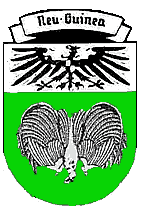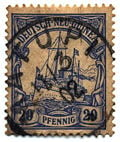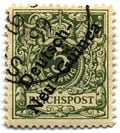German New Guinea
 From Nwe
From Nwe 
German New Guinea (Ger. Deutsch-Neuguinea) was a former German protectorate from 1884 to 1914 within the German colonial empire, consisting of the northeastern part of New Guinea and several nearby island groups. German New Guinea is now entirely part of Papua New Guinea. The main part of German New Guinea was formed by Kaiser-Wilhelmsland, the northeastern part of New Guinea. The islands to the east of Kaiser-Wilhelmsland were called the Bismarck Archipelago and consisted of Neu-Pommern (or New Pomerania, now New Britain) and Neu-Mecklenburg (now New Ireland). With the exception of German Samoa, all German islands in the Pacific were administratively part of German New Guinea: the German Solomon Islands (Buka, Bougainville and several smaller islands), the Carolines, Palau, the Marianas (except for Guam), the Marshall Islands and Nauru. Total land area was 249,500 km².
From the point of view of the local population, the Germans left little real lasting impact on their life, except that people were alerted to the reality of a wider world and to the existence of technologies of which they were previously unaware. Due to the way that Germany lost her colonies, including New Guinea, which were confiscated by the victors of World War I German colonies never engaged in lengthy wars of independence. Germany's history in the twentieth century resulted in reflection on the colonial experience receiving less attention than it has in other former colonial powers. Instead, Germany's role in two World Wars and the Holocaust has dominated thinking in terms of re-negotiating national identity. It may be that little of value that can be salvaged from the legacy of the German presence in Melanesia.
Background
Owing to its delayed unification by land-oriented Prussia in 1871, Germany came late to the imperialist scramble for colonial territory—their so-called "place in the sun." [1]. The German states prior to 1870 had retained separate political structures and goals, and German foreign policy up to and including the age of Otto von Bismarck concentrated on resolving the "German question" in Europe and securing German interests on that same continent. On the other hand, Germans had traditions of foreign sea-borne trade dating back to the Hanseatic League; a tradition existed of German emigration (eastward in the direction of Russia and Romania and westward to North America); and North German merchants and missionaries showed lively interest in overseas lands.
Many Germans in the late nineteenth century viewed colonial acquisitions as a true indication of having achieved nationhood, and the demand for prestigious colonies went hand-in-hand with dreams of a High Seas Fleet. This become a reality and was soon perceived as a threat by the United Kingdom. Initially, Bismarck—whose Prussian heritage had always regarded Europe as the space in which German imperialist ambition found expression—opposed the idea of seeking colonies. He argued that that the burden of obtaining and defending them would outweigh the potential benefits. During the late 1870s, however, public opinion shifted to favor the idea of a colonial empire. During the early 1880s the first colonial possessions and protectorates were acquired. Several colonial adventures, including that in German New Guinea, began with the chartering of a Company.
History

Although the western half of New Guinea had been administered by the Netherlands for some time, the eastern half had not yet been annexed by any European power until the 1880s. In 1883, the British colony of Queensland (Australia) annexed the southeastern part of New Guinea against the wishes of the British government. This initiated German interest in the remaining third of the island. On November 3, 1884, under the flag of the newly founded Neuguinea-Kompanie (New Guinea Company), the German flag was flown over Kaiser-Wilhelmsland, the Bismarck Archipelago (formerly New Britain) and the German Solomon Islands. This secured "nearly a quarter of New Guinea" for Germany.[2] Not everyone in Germany expressed enthusiasm for the project; the German High Command pointed out that the island had no strategic value and were too far from Germany to "have any military use."[3]
On April 1, 1899 the German government formally took control of these lands, and the area became a protectorate. A treaty with Spain, signed later that year on July 30, ensured German control over several island groups in the Pacific, and these were added to the protectorate of German New Guinea. The Marshall Islands were added in 1906.
Economy
Until 1908, New Guinea was the "most heavily subsidized of all German colonies"[4] although when established the aim had been for the colony to produce a profit.[5] Many local people refused to work on the German plantations, and those that did often died. Too few Germans settled in the colony to provide adequate labor. The reason that the German government took over control from the New Guinea Company was that by 1899 "nine million marks" had been, "like the dead, buried in the soil of Kaiser-Wilhelmsland."[5] The Company itself remained a major commercial player in the region because after taking the German government obliged the colony to pay "four hundred thousand marks" to the company annually for the next ten years.[6]
Henderson points out that elsewhere in the German colonial empire Companies were relieved of the responsibility of governance due to failure to maximize a profit but also continued to be subsidized, as in East Africa.[7] Reasons for the Company's failure include the distance from the Metropole, the lack of links with "world trade routes" and an inhospitable climate and landscape that prevented opening up the hinterland.[8] It was inability to integrate the local population into the economy that hampered all efforts at sustainability let alone producing a surplus, plus the cost of subsidizing the Company. On the other hand, according to Hiery, the German government realized that it would take longer for the islands in the East to produce a profit and were more relaxed about this. While colonial officials in Germany's African colonies tended to be [[nobility}aristocrats]], those in the East tended to be middle-class University graduates. Many, he says, pursued other interests while stationed there, such as studying the geography or ethnography of the region.[9]
Relations with the Melanesian population
The inland areas of the colony remained untapped as a source of labor. The local population retaliated against forced recruitment, and attacked new plantations. This was largely because in the hinterland, the flag followed trade not vice-versa which meant that the rule of law legged behind and harsh measures against the populace only increased resentment.[6] The Germans paid the lowest wages in Melanesia.[10] Judge Albert Halh, governor from 1902 until 1914, tried to "establish a systematic administration" and recruited a "local police force of six hundred men."[6] He introduced forced labor in 1903 and appointed village elders to assist with recruitment. He did try to introduce some humane labor rules but this met with resistance from the plantation owners. When plantations expanded, local people were dispossessed of their land.[11] A rebellion during 1904, involving ex-policemen, failed when news of the plan leaked to the Germans. Another plot was uncovered in 1912 and after suspects had been rounded up this effectively ended resistance until the end of World War II when Germany lost the colony.
Some Madang people believed that the advanced technology used by the Germans to subdue was actually the invention of two of their own deities. Unfortunately, the people had rejected this technology which the Germans had embraced. One day, however, the two deities, who had left the island, would return and equip the people with the white's "goods ... including their weapons."[11] The Germans killed more Melanesians than "the Dutch, British or Australians."[10] Governor Hahl did try to preserve "the indigenous population in the face of settler demands" but with very limited success.[12] Hiery describes Hahl as an "exceptional man" who genuinely tried to learn from mistakes made elsewhere as well as from the example set by other colonial rulers, such as the British.[13] He describes how the Germans succeeded in ending inter-tribal conflict by "fighting (and thus damaging) belligerent tribes until they gave up."[14] Hiery says that under Halh there was a marked tendency to "tolerate indigenous ideas of behavior" and genuine concern for the welfare of the non-settler population.[15]
End of the Protectorate
Following the outbreak of World War I, Australian troops captured Kaiser-Wilhelmsland and the nearby islands in 1914, after a short resistance led by Captain Carl von Klewitz and Lt. Robert "Lord Bob" von Blumenthal, while Japan occupied most of the remaining German possessions in the Pacific. The colony was too far from Germany to be protected, as the German High Command had predicted. The only significant battle occurred on September 11, 1914 when the Australian Naval and Military Expeditionary Force attacked the low-power wireless station at Bitapaka (near Rabaul) on the island of New Britain (Neu Pommern). The Australians suffered six dead and four wounded—the first Australian military casualties of the First World War. The German forces fared much worse, with one German officer and 30 native police killed and one German officer and ten native police wounded. On September 21 all German forces in the colony surrendered.
However, Leutnant (later Hauptmann) Hermann Detzner, a German officer, and some 20 native police evaded capture in the interior of New Guinea for the entire war. Unbeknownst to Detzner, the war had started while he was still on a surveying expedition to map the border with Australian-held Papua. He claimed to have penetrated the interior of the German portion (Kaiser Wilhelmsland) in his 1920 book Vier Jahre unter Kannibalen ("Four Years Among Cannibals"). These claims were heavily disputed by various German missionaries, and Detzner recanted most of his claims in 1932.
After the Treaty of Versailles of 1919, Germany lost all its colonial possessions, including German New Guinea. It became the Territory of New Guinea, a League of Nations Mandate Territory under Australian administration until 1949 when it was merged with the Australian territory of Papua to become the Territory of Papua and New Guinea, which eventually became modern Papua New Guinea.
Postage stamps


The first postage stamps of the colony were issued in 1897, as overprints reading "Deutsch - / Neu-Guinea" on the current stamps of Germany. In 1901, the Yacht issue included stamps for the colony, inscribed "DEUTSCH-NEU-GUINEA." The 5pf, 10pf, and 5m values were reprinted in 1914 on watermarked paper and inscribed "DEUTSCH-NEUGUINEA," but these did not reach the colony before it was occupied and were never put in use, nor was the reprint of the 3pf value made in 1919.
The stamps are available to collectors today at prices ranging from about $1 US, up to $500 for a validly used 5m stamp. Very few stamps of the higher values were ever used, and their prices are 10-20 times higher than for mint copies. Fake cancellations exist.
After the Australian occupation, stocks of the unwatermarked stamps, along with some registration labels, were overprinted with "G.R.I." and a value in pence or shillings; see New Britain for further details.
Legacy
The German experience of overseas colonialism was short-lived. In New Guinea as elsewhere Germans did not leave behind them a large German educated and German-speaking population. While no non-European country has made German an official language. In contrast, French is an official language in 28 countries spread across the globe. One result of this is " "there are apparently no post-colonial texts in German" in which writers analyze and discuss their identities and relations with the former colonial power.[16] From the point of view of the local population, the Germans made little real lasting impact on their life except that people were alerted to the reality of a wider world and to the existence of technologies of which they were previously unaware. Due to the way that Germany lost her colonies, including New Guinea, German colonies never engaged in lengthy wars of independence. Germany's history in the twentieth century resulted in reflection on the colonial experience receiving less attention than it has had in other former colonial powers. Germany's role in two World Wars and the Holocaust has dominated thinking in terms of re-negotiating national identity.
Notes
- ↑ Wehler 1985, 64.
- ↑ Henderson 1976, 22.
- ↑ Hiery 1995, 1.
- ↑ Howe, Kiste, and Lal 1994, 65.
- ↑ 5.0 5.1 Howe, Kiste, and Lal 1994, 53.
- ↑ 6.0 6.1 6.2 Howe, Kiste, and Lal 1994, 54.
- ↑ Henderson 1976, 21.
- ↑ Henderson 1976, 24.
- ↑ Hiery 1995, 2.
- ↑ 10.0 10.1 Howe, Kiste, and Lal 1994, 56.
- ↑ 11.0 11.1 Howe, Kiste, and Lal 1994, 55.
- ↑ Howe, Kiste, and Lal 1994, 62.
- ↑ Hiery 1995, 3.
- ↑ Hiery 1995, 5.
- ↑ Hiery 1995, 6.
- ↑ Denham, Kacandes, and Petropoulos 1997, 202.
References
ISBN links support NWE through referral fees
- Denham, Scott D., Irene Kacandes, and Jonathan Petropoulos. A User's Guide to German Cultural Studies. Social History, Popular Culture, and Politics in Germany. Ann Arbor, MI: University of Michigan Press, 1997. ISBN 978-0472066568.
- Henderson, William O. Studies in German Colonial History. London, UK: Cass, 1976 (original 1962). ISBN 978-0714616742.
- Hiery, Hermann. The Neglected War: The German South Pacific and the Influence of World War I. Honolulu, HI: University of Hawaiʻi Press, 1995. ISBN 978-0824816681.
- Howe, K.R., Robert C. Kiste, and Brij V. Lal. Tides of History: The Pacific Islands in the Twentieth Century. Honolulu, HI: University of Hawaii Press, 1994. ISBN 978-0824815974.
- Moses, John Anthony, and Paul M. Kennedy. Germany in the Pacific and Far East, 1870-1914. St. Lucia, LC: University of Queensland Press, 1977. ISBN 978-0702213304.
- Wehler, Hans Ulrich. The German Empire, 1871-1918. Leamington Spa, Warwickshire, UK: Berg Publishers, 1985. ISBN 978-0907582229.
Credits
New World Encyclopedia writers and editors rewrote and completed the Wikipedia article in accordance with New World Encyclopedia standards. This article abides by terms of the Creative Commons CC-by-sa 3.0 License (CC-by-sa), which may be used and disseminated with proper attribution. Credit is due under the terms of this license that can reference both the New World Encyclopedia contributors and the selfless volunteer contributors of the Wikimedia Foundation. To cite this article click here for a list of acceptable citing formats.The history of earlier contributions by wikipedians is accessible to researchers here:
- German New Guinea history
The history of this article since it was imported to New World Encyclopedia:
- History of "German New Guinea"
Note: Some restrictions may apply to use of individual images which are separately licensed.
↧ Download as ZWI file | Last modified: 02/04/2023 01:29:54 | 13 views
☰ Source: https://www.newworldencyclopedia.org/entry/German_New_Guinea | License: CC BY-SA 3.0
 ZWI signed:
ZWI signed: KSF
KSF